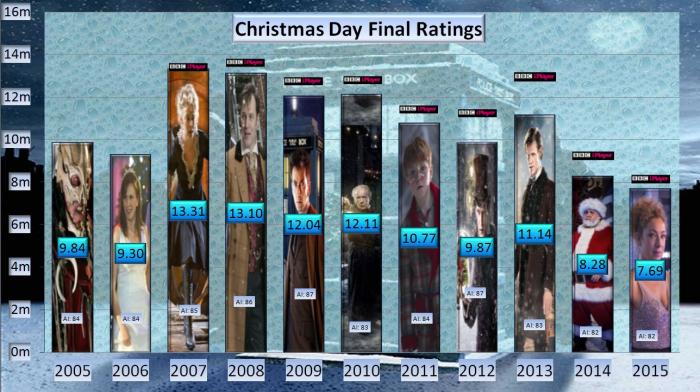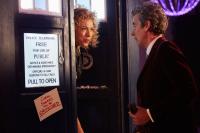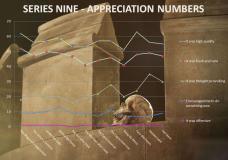Live +7 Figures are now available for the first half of Series Nine.
The Live+7 figure is calculated by the BBC to try to get an accurate estimate of the total unique audience for an episode of a programme. Unlike official BARB figures the Live+7 uses data to include those who watched one of the broadcast repeats of the episode and those who watched the episode on iPlayer all within 7 days of the original transmission.
The figures show an average of
60% of the audience watch Doctor Who on the day of transmission, either as a Live broadcast or as a delayed viewing via a PVR. A further 26.8% of the audience watch the programme, via a recording, within 7 days of the original transmission. 11.9% now watch on iPlayer, up from an average of 9% last year.
The number watching a scheduled repeat has dropped sharply this year, from an average of 4% last year, to an average of just 1.3% this year. With on demand services now so readily available, the audience no longer needs to seek out a scheduled repeat to catch up with the programme. The decline of the audience watching on BBC Three caused the BBC to cancel the regular repeat on BBC Three from episode four onwards. The only repeat was the late night. signed version on BBC Two, which had an average of 40,000 viewers.
Overall Doctor Who's total Live +7 ratings are down around 1.5 million on the 2014 figures, to average a total of around 6.8 million watching each episode.
Further analysis of the
Appreciation Index figures are available, with a marked difference in appreciation between different age groups. The
16-34 age group appeared to enjoy the series far more than the over
55 group. While there have been small differences in AI figures previous years, the contrast this year is quite large, with the lower age group scoring the series around 5 points higher than the older viewers.
The most marked difference was for the penultimate episode featuring just the Doctor, Heaven Sent, which scored an AI figure of 85 for viewers aged 16-34, but only 76 for those aged over 55.
The female viewers rated the series slightly higher than the male viewers, although the programme is now watched by slightly more male viewers than female with an average of 52% of the audience being male, in contrast to a 50/50 split in past years.
The AI panel is also asked questions on how they see the series, with around 59% thinking it is high quality and 50% felt it was fresh and new. Around 20% of the audience felt the initial stories were thought provoking, with the figure rising to over 30% near the end of the series. 1% found them offensive.
 Doctor Who Series Nine has been voted the Best Reviewed TV Sci-Fi/Fantasy/Horror Series of 2015 on the review site Rotten Tomatoes.
Doctor Who Series Nine has been voted the Best Reviewed TV Sci-Fi/Fantasy/Horror Series of 2015 on the review site Rotten Tomatoes. 

































